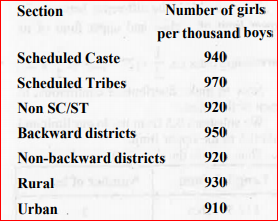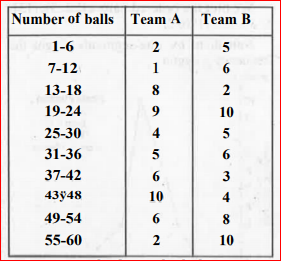Complete Solutions to EXERCISE of chapter STATISTICS of Class 9 book with complete answers and questions
| Class 9 | MATHS |
| Chapter | STATISTICS |
| PSEB | EXERCISE |
| Number Of Questions | 25 |
| Academic Year | 2023-24 |
Give some examples of data that you can collect from your day to day life.
View SolutionClassify the data in Above as primary and secondary data.
View SolutionThe blood groups of 30 students of Class VIII are recorded as follows: A, B, O, O, AB, O, A, O, B, A, O, B, A, O, O, A, AB, O, A, A, O, O, AB, B, A, O, B, A, B, O. Represent this data in the form of a frequency distribution table. Which is the most common, and which is the rarest, blood group among these students?
View SolutionDistance (in km) of 40 engineers from their place of residence to their place of work were found as follows
 Construct n grouped frequency distribution table with class size 5 for the data given above taking the first interval as 0— 5 (5 not included). What main features do you observe from this tabular representation ?
Construct n grouped frequency distribution table with class size 5 for the data given above taking the first interval as 0— 5 (5 not included). What main features do you observe from this tabular representation ?
View SolutionThe relative humidity (in %) of a certain city for a month of 30 days was as follows :
 : Construct a grouped frequency distribution table with classes 84 - 86, 86-88 etc.
: Construct a grouped frequency distribution table with classes 84 - 86, 86-88 etc.
View SolutionThe length ,breadth and height of a room are 6m,5m and 4m respectively. Find the cost of white washing the walls of the room and the ceiling at the rate of Rs 10.50 per m^2.
View SolutionA study was conducted to find out the concentration of sulphur dioxide in the air in parts per million (ppm) of a certain city. The data obtained for 30 days is as follows :
 Make a grouped frequency distribution table for this data with class intervals as 0.00 - 0.04, 0.04 -0.08 and so on.
Make a grouped frequency distribution table for this data with class intervals as 0.00 - 0.04, 0.04 -0.08 and so on.
View SolutionThree coins were tossed 30 times simultaneously.Each time thenumber of heads occurring was noted down asfollows :
 Prepare a frequency distribution for the data given above
Prepare a frequency distribution for the data given above
View SolutionThe value of `pi` upto 50 decimal places is given below: 3.14159265358979323846264338327950288419716939937510 (i) Make a frequency distribution of the digits from 0 to 9 after the decimal point. (ii) What are the most and the least frequently occurring digits?
View SolutionThirty children were asked about the number of hours they watched TV programmes in the previous week. The results were found as follows :
 : Make a frequency distribution table for this data, taking class width 5 and one of the class interval as 5— 10
: Make a frequency distribution table for this data, taking class width 5 and one of the class interval as 5— 10
View SolutionA company manufactures carbatteries of particular type. The lives (in years) of 40 such batteries were recorded as follows :
 Construct a grouped frequency distribution table for this data, using class intervals of size 0.5 starting from the interval 2— 2.5.
Construct a grouped frequency distribution table for this data, using class intervals of size 0.5 starting from the interval 2— 2.5.
View SolutionThe following data on the number of girls (to the nearest ten) per thousand boys in different sections of Indian Society is given below :
 : Represent the information above by a bar graph
: Represent the information above by a bar graph
View SolutionGiven below are the seats won by different political parties in the polling outcome of a state assembly elections :
 : Draw a bar graph to represent the polling results.
: Draw a bar graph to represent the polling results.
View SolutionThe length of 40 leaves of a plant are measured correct to one millimetre, and the obtained data is represented in the following table.
 : Draw a histogram to represent the given data.
: Draw a histogram to represent the given data.
View SolutionThe following table gives the life times of 400 neon lamps :
 : Represent the given information with the help of a histogram.
: Represent the given information with the help of a histogram.
View SolutionThe following table gives the distribution of students of two sections according to the marks obtained by them :
 : Represent the marks of the students of both the sections on the same graph by two frequency polygons. From the two polygons compare the performance of the twosections.
: Represent the marks of the students of both the sections on the same graph by two frequency polygons. From the two polygons compare the performance of the twosections.
View SolutionThe runs scored by two teams A and B in the first 60 balls in a cricket match are given below :
 : Represent the data of both the teams on the same graph by frequency polygons.
: Represent the data of both the teams on the same graph by frequency polygons.
View Solution100 surnames were randomly picked up from a local telephone directory and a frequency distribution of the number of letters in the English alphabet in the surnames was found as follows :
 : Draw a histogram to depict the given information.
: Draw a histogram to depict the given information.
View SolutionThe following number of goals were scored by a team in a series of 10 matches : 2, 3, 4, 5, 0, 1, 3, 3, 4, 3 Find mean, median and mode of these scores :
View SolutionIn a mathematics test given to 15 students, the following marks (out of 100) are recorded: 41, 39, 48, 52, 46, 62, 54, 40, 96, 52, 98, 40, 42, 52, 60 Find the mean, median and mode of this data.
View SolutionThe following observations have been arranged in ascending order. If the median of the data is 63, find the value of x. 29, 32, 48, 50, x, x + 2, 72, 78, 84, 95
View SolutionFind the mode of 14, 25, 14, 28, 18, 17, 18, 14, 23, 22, 14, 18.
View SolutionFind the mean salary of 60 workers of a factory from the following table :

View SolutionGive an example of a situation in which : the mean is an appropriate measure of central tendency.
View SolutionGive one example of a situation in which the mean is not an appropriate measure of central tendency but the median is an appropriate measure of central tendency.
View Solution
EXERCISE questions and complete solutions for chapter STATISTICS of PSEB of Class 9